Capital One 2013 Annual Report Download - page 261
Download and view the complete annual report
Please find page 261 of the 2013 Capital One annual report below. You can navigate through the pages in the report by either clicking on the pages listed below, or by using the keyword search tool below to find specific information within the annual report.-
 1
1 -
 2
2 -
 3
3 -
 4
4 -
 5
5 -
 6
6 -
 7
7 -
 8
8 -
 9
9 -
 10
10 -
 11
11 -
 12
12 -
 13
13 -
 14
14 -
 15
15 -
 16
16 -
 17
17 -
 18
18 -
 19
19 -
 20
20 -
 21
21 -
 22
22 -
 23
23 -
 24
24 -
 25
25 -
 26
26 -
 27
27 -
 28
28 -
 29
29 -
 30
30 -
 31
31 -
 32
32 -
 33
33 -
 34
34 -
 35
35 -
 36
36 -
 37
37 -
 38
38 -
 39
39 -
 40
40 -
 41
41 -
 42
42 -
 43
43 -
 44
44 -
 45
45 -
 46
46 -
 47
47 -
 48
48 -
 49
49 -
 50
50 -
 51
51 -
 52
52 -
 53
53 -
 54
54 -
 55
55 -
 56
56 -
 57
57 -
 58
58 -
 59
59 -
 60
60 -
 61
61 -
 62
62 -
 63
63 -
 64
64 -
 65
65 -
 66
66 -
 67
67 -
 68
68 -
 69
69 -
 70
70 -
 71
71 -
 72
72 -
 73
73 -
 74
74 -
 75
75 -
 76
76 -
 77
77 -
 78
78 -
 79
79 -
 80
80 -
 81
81 -
 82
82 -
 83
83 -
 84
84 -
 85
85 -
 86
86 -
 87
87 -
 88
88 -
 89
89 -
 90
90 -
 91
91 -
 92
92 -
 93
93 -
 94
94 -
 95
95 -
 96
96 -
 97
97 -
 98
98 -
 99
99 -
 100
100 -
 101
101 -
 102
102 -
 103
103 -
 104
104 -
 105
105 -
 106
106 -
 107
107 -
 108
108 -
 109
109 -
 110
110 -
 111
111 -
 112
112 -
 113
113 -
 114
114 -
 115
115 -
 116
116 -
 117
117 -
 118
118 -
 119
119 -
 120
120 -
 121
121 -
 122
122 -
 123
123 -
 124
124 -
 125
125 -
 126
126 -
 127
127 -
 128
128 -
 129
129 -
 130
130 -
 131
131 -
 132
132 -
 133
133 -
 134
134 -
 135
135 -
 136
136 -
 137
137 -
 138
138 -
 139
139 -
 140
140 -
 141
141 -
 142
142 -
 143
143 -
 144
144 -
 145
145 -
 146
146 -
 147
147 -
 148
148 -
 149
149 -
 150
150 -
 151
151 -
 152
152 -
 153
153 -
 154
154 -
 155
155 -
 156
156 -
 157
157 -
 158
158 -
 159
159 -
 160
160 -
 161
161 -
 162
162 -
 163
163 -
 164
164 -
 165
165 -
 166
166 -
 167
167 -
 168
168 -
 169
169 -
 170
170 -
 171
171 -
 172
172 -
 173
173 -
 174
174 -
 175
175 -
 176
176 -
 177
177 -
 178
178 -
 179
179 -
 180
180 -
 181
181 -
 182
182 -
 183
183 -
 184
184 -
 185
185 -
 186
186 -
 187
187 -
 188
188 -
 189
189 -
 190
190 -
 191
191 -
 192
192 -
 193
193 -
 194
194 -
 195
195 -
 196
196 -
 197
197 -
 198
198 -
 199
199 -
 200
200 -
 201
201 -
 202
202 -
 203
203 -
 204
204 -
 205
205 -
 206
206 -
 207
207 -
 208
208 -
 209
209 -
 210
210 -
 211
211 -
 212
212 -
 213
213 -
 214
214 -
 215
215 -
 216
216 -
 217
217 -
 218
218 -
 219
219 -
 220
220 -
 221
221 -
 222
222 -
 223
223 -
 224
224 -
 225
225 -
 226
226 -
 227
227 -
 228
228 -
 229
229 -
 230
230 -
 231
231 -
 232
232 -
 233
233 -
 234
234 -
 235
235 -
 236
236 -
 237
237 -
 238
238 -
 239
239 -
 240
240 -
 241
241 -
 242
242 -
 243
243 -
 244
244 -
 245
245 -
 246
246 -
 247
247 -
 248
248 -
 249
249 -
 250
250 -
 251
251 -
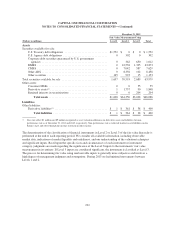 252
252 -
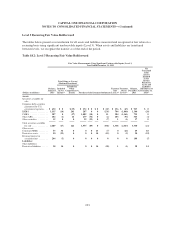 253
253 -
 254
254 -
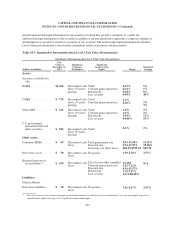 255
255 -
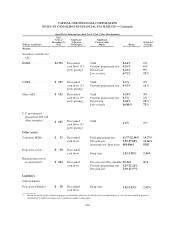 256
256 -
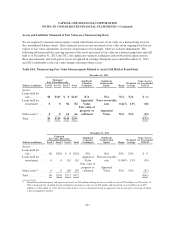 257
257 -
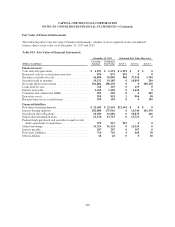 258
258 -
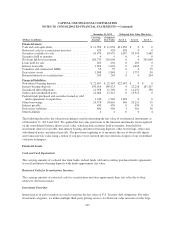 259
259 -
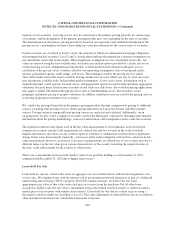 260
260 -
 261
261 -
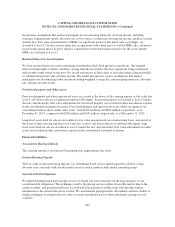 262
262 -
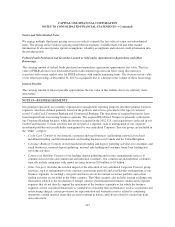 263
263 -
 264
264 -
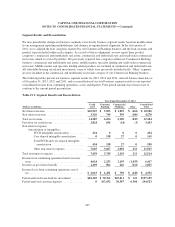 265
265 -
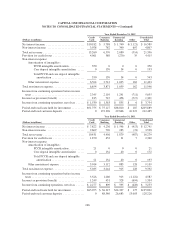 266
266 -
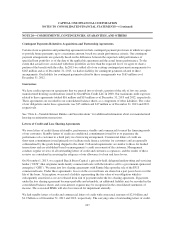 267
267 -
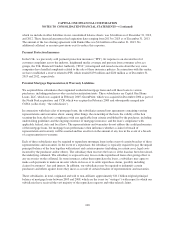 268
268 -
 269
269 -
 270
270 -
 271
271 -
 272
272 -
 273
273 -
 274
274 -
 275
275 -
 276
276 -
 277
277 -
 278
278 -
 279
279 -
 280
280 -
 281
281 -
 282
282 -
 283
283 -
 284
284 -
 285
285 -
 286
286 -
 287
287 -
 288
288 -
 289
289 -
 290
290 -
 291
291 -
 292
292 -
 293
293 -
 294
294 -
 295
295 -
 296
296 -
 297
297 -
 298
298 -
 299
299 -
 300
300 -
 301
301 -
 302
302
 |
 |
CAPITAL ONE FINANCIAL CORPORATION
NOTES TO CONSOLIDATED FINANCIAL STATEMENTS—(Continued)
Net Loans Held For Investment
Loans held for investment that are individually impaired are carried at the lower of cost or fair value of the
underlying collateral, less the estimated cost to sell. The fair values of credit card loans, installment loans, auto
loans, home loans and commercial loans were estimated using a discounted cash flow method, a form of the
income approach. Discount rates were determined considering rates at which similar portfolios of loans would be
made under current conditions and considering liquidity spreads applicable to each loan portfolio based on the
secondary market. The fair value of credit card loans excluded any value related to customer account
relationships.
Due to the use of unobservable inputs, loans held for investment are classified as Level 3 under the fair value
hierarchy. Fair value adjustments for loans held for investment are recorded in provision for credit losses in the
consolidated statement of income. The fair value of these loans as of December 31, 2013 remained substantially
unchanged compared to the previous year as the impact of higher market rates was offset by improved credit
performance in our card, mortgage and commercial loan portfolios.
Interest Receivable
The carrying amount of interest receivable approximates the fair value of this asset due to its relatively
short-term nature.
Derivative Assets and Liabilities
We use both exchange-traded derivatives and over-the-counter (“OTC”) derivatives to manage our interest rate
and foreign currency risk exposure. Quoted market prices are available and used for our exchange-traded
derivatives, which we classify as Level 1. However, substantially all of our derivatives are traded in OTC
markets where quoted market prices are not always readily available. Therefore, we value most OTC derivatives
using valuation techniques, which include internally-developed models. We primarily rely on market observable
inputs for our models, such as interest rate yield curves, credit curves, option volatility and currency rates, that
vary depending on the type of derivative and nature of the underlying rate, price or index upon which the
derivative’s value is based. Where model inputs can be observed in a liquid market and the model does not
require significant judgment, such derivatives are typically classified as Level 2 of the fair value hierarchy. When
instruments are traded in less liquid markets and significant inputs are unobservable, such as interest rate swaps
whose remaining terms do not correlate with market observable interest rate yield curves, the derivatives are
classified as Level 3.
The impact of counterparty non-performance risk is considered when measuring the fair value of derivative
assets. These derivatives are included in other assets on the balance sheet.
We validate the pricing obtained from the internal models through comparison of pricing to additional sources,
including external valuation agents and other internal sources. Pricing variances among different pricing sources
are analyzed and validated.
Mortgage Servicing Rights
We record consumer MSRs at fair value on a recurring basis, while commercial MSRs are subsequently
measured at amortized cost with impairment recognized as a reduction in other non-interest income. MSRs do
not trade in an active market with readily observable prices. Accordingly, we determine the fair value of MSRs
using a valuation model that calculates the present value of estimated future net servicing income. The model
241
